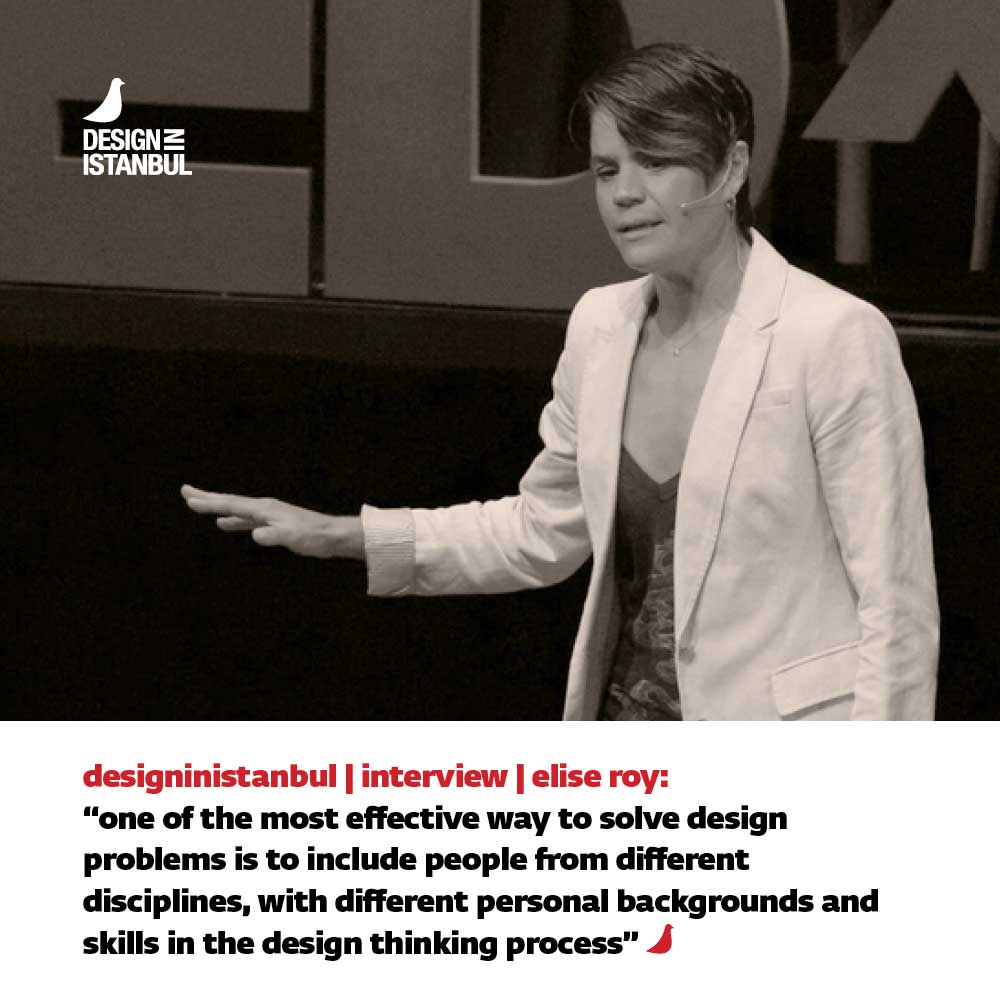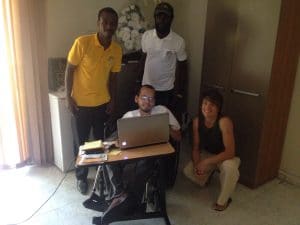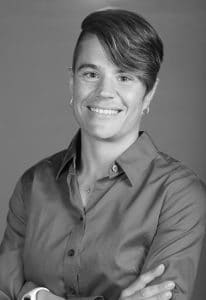
06 Apr interview | elise roy: “one of the most effective way to solve design problems is to include people from different disciplines, with different personal backgrounds and skills in the design thinking process”
Describing herself as a “deaf lawyer, artist, artisan, and a human rights advocate who works in the vanguard of the social design movement”, Elise Roy is an inspiring personality whose voice has risen with a unique proposition to the design community as she has combined all these qualities together. She is as positive as she acknowledges her hearing loss as one of the greatest gifts as she ever received. She transforms this gift into a bigger value production in the domain of disabilities. Her proposition bears the basic qualities of design, yet combines them with practical reasoning and a plain description. “Designing for extremes, creates solutions that are better than when we design for the norm; and people with disabilities are great examples of extreme users,” she argues. Knowing her from her inspiring TED Talk titled “when we design for disability, we all benefit”, we thank to Elise Roy for this motivating interview, and her warm contribution.
Dear Elise Roy. Thank you for being part of the designinistanbul interviews. The world knows you most with your inspiring TED Talk on design and disability in which you highlight that designing for disability would yield to greater values and benefits for all. Do you also propose or prescribe a kind of transformation in the design process(es) with this statement?
Yes, I do. Recently I have been researching ways to redesign the design thinking process from a disability perspective. For example, often the design process requires a lot of communication and facilitation. As someone with a severe hearing loss, this type of environment can be challenging if I do not have access to an interpreter. I have begun using voice recognition apps to aid the process. These apps, although definitely helpful, every once in a while mix up words. So I have begun to use these ‘mix ups’ as design prompts, to try to get people to think outside the box. Another example is the fact that we often encourage people to be on their feet during the design thinking process because it makes them be more creative. But how would someone in a wheelchair tackle this? How do they get their creative juices flowing? Maybe we can learn something there as well.
 In line with this statement, you actively involve in design projects as a consultant, like the project you worked for the displaced deaf community in Haiti. It sounds like these projects require a certain collective mind including the disability aspect to the design process. If you think so (if you think that it is a kind of collective), would you expand on the ways in which the elements of these collectivities (can) work together?
In line with this statement, you actively involve in design projects as a consultant, like the project you worked for the displaced deaf community in Haiti. It sounds like these projects require a certain collective mind including the disability aspect to the design process. If you think so (if you think that it is a kind of collective), would you expand on the ways in which the elements of these collectivities (can) work together?
One of the most effective way to solve design problems is to include people from different disciplines, with different personal backgrounds and skills in the design thinking process. This allows us to apply similar thinking from one field to another and better solve problems. People with disabilities unique experiences fill a critical component in this. Design is always better if there is more than one person involved.
Since you are also a lawyer, we would also like to ask you about copyrights. How does your area of consultancy including design and creative thinking deal with the copyright issues and matters?
Right now, I do not actively practice law. Before, I was a civil rights lawyer and international human rights policy analyst so I am not knowledgeable in copyright law.
What about your opinions on the ways in which disability-sensitive design projects relate to the industries, sponsors or other financial resources/institutions in the realization of these projects?
The neat thing about inclusive design or designing for disability is that there is great value in it for everyone, making it a process that should not be dependent on any financial donation. Every company, organization, or government entity, who does innovation or has a problem that they want to solve will benefit from examining it through a disability centric lens. This is what excites me about design thinking. There is so much potential and unlike in other realms, inserting disability into the design process is not about charity (for lack of a better word) but instead about capitalizing on an amazing asset. People with disabilities have this unique ability to uncover hidden needs and it is in those hidden needs that we find the most innovative solutions. My company works with organizations to analyze problems from the vantage point of people with disabilities to disrupt markets and industries. Essentially, we use inclusive design as an idea incubator.
What would you say about the involvement of the other domains to the design process insofar as the disabilities are concerned? Do you think the involvement of craft and arts to the design process would also yield to greater values and benefits for all? Could craft, art and design work as a collective, address disability issues and produce greater value for humankind, societies, cities, nature and life, more than their individual potentialities?
If harnessed right, I think disability can be a benefit to almost all sectors. For example, in the craft, art and design realm, what if you took your next project and asked yourself, how would someone who is deaf, in a wheelchair, or blind approach this? Place yourselves in their shoes – empathize with them – truly feel all the different ways they may experience the world and then apply it to your work. I have no doubt that it will spur new designs and crafts that will be cutting edge.
As highlighted at your TED biography, you think that designers have the capacity and responsibility to address and resolve human problems and contribute to social well-being? How do you ground this responsibility? On what basis do you hold designers responsible to address and resolve human problems?
Part of being a designer is about resolving and reacting to human problems. For example, if you are trying to communicate a message, you must resolve the problem of how to attract people’s attention. You ask yourself, what are the best colors? What font will catch their eye? What is the best strategic placement of the graphics? If you are designing a sofa you have to resolve the problem of how to fit it to the human body so that people will want to sit on it. Designers are constantly reacting to human problems. So we know they have the capacity to empathize with human needs if they are any good. Many professions, such as the legal profession, requires its members to do pro bono work. Why are we not also doing this in the design profession? We need to actively engage and encourage them in using their skills for social good. I think a part of this is educating design professionals about the opportunities and different ways that they can put their skills to social good work.
You highlight the importance of the idea of ‘design thinking’, the ways in which it is such a comprehensive concept that can be thought as a way of policy making and implementation, and that disability rights should be incorporated into this thinking in a broader sense. The stress of the question is not indeed on the ‘problem areas’, but on the possible ways in which this broad idea can be acknowledged in a broader sense. What else do you think can be done to achieve the broader acknowledgement of this idea?
I think it falls on organizations, associations, and conferences to spread the word and embrace the concept. It is important for them to recognize how much of a competitive advantage they gain in exposing employees to this concept and outfitting them with the skills necessary to employ it in their work. We would also benefit from additional research that supports the concept. Microsoft is one of the few tech companies that has begun to recognize the power of looking to people with disabilities to help them solve problems and create innovations geared towards everyone, disability or not.
 Elise Roy
Elise Roy
Elise Roy is a deaf Inclusive Design Strategist who helps companies analyze problems from the vantage point of people with disabilities to disrupt markets and industries. She believes strongly that the unique experiences of people with disabilities help us uncover hidden needs and it is in these hidden needs where we often find the most innovative solutions. Her company, Elise Roy & Associates has attracted tech start-ups, as well as policy and development organizations such as the OECD and USAID. Her TED talk, “When We Design for Disability, We All Benefit” has over 1 million views.
Elise draws on her richly diverse career path as a human rights lawyer, marketer, and product designer to shape solutions for her clients. As a lawyer, Elise was the leader of the culture, sport, recreation and leisure article of the United Nations Convention on the Rights of Persons with Disabilities. As a marketer, she directed ads that reached hundreds of thousands. And as a product designer, she designed safety glasses for deaf wood workers that were hailed by DeWalt as ‘revolutionary.’ Elise has given talks around the world including, Microsoft, the National Science Foundation, the United Nations and the World Bank.
www.eliseroy.org | twitter: @EliseRoy
